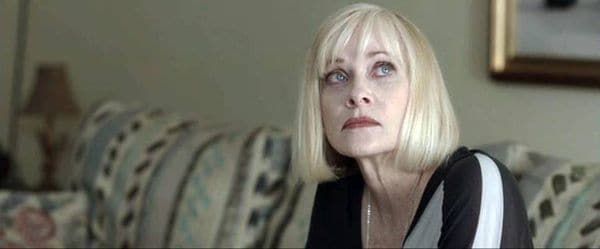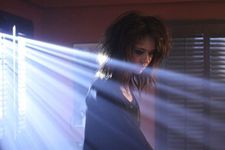 |
| Barbara Crampton plays an actress whose daughter - thought dead - returns to complicate her life in Reborn |
In the early part of the century, director Julian Richards made a big splash with films like Silent Cry and The Last Horror Movie. His was a distinctive voice and fans were eager to see what he would do next, but after 2007’s Summer Scars and a 2009 documentary about Charles Dickens, he disappeared from the radar. This year saw him return with two very different horror films, Daddy’s Girl and Reborn. I caught up with him after Halloween Frightfest, which screened the latter, to ask where he’s been all this time.
“It’s generally because it does take a while to develop a project with things like getting finance and getting it into production,” he explains. ”It often takes three or four years to go through that whole process and even then that’s if your lucky enough to get the support for finance that you need. I’ve been making films now for over 15 years, getting bolder and having more responsibilities, and in that process, with the digitisation of film and the way that film’s value has devolved, it has become a relatively unviable occupation financially. So what I did is I moved into sales. I run a sales company called Jinga Films so we represent films and we sell them to distributors worldwide. I take a commission from that and that became my income.
 |
| Julian Richards Photo: Dekalog |
“It took me a while to set that company up and establish it so it was ready to run on its own two feet, and once I’d done that then I was able to re-focus on directing again. Actually it took ten years to set up the company and establish it, but I always had the intention of returning to directing. Last year was one of those unique years of opportunity. Both the projects came to me. One of them came from a company in India who were looking to do a slate of genre films – that was Daddy’s Girl – and with Reborn I was approached by some acquaintances of mine from the US who were looking for a director for a low-budget film. They came to me, actually, because as a sales agent I would know lots of directors, and they were wondering who I would recommend, so I recommended myself!”
Both his new films feature young women who have difficult relationships – to say the last – with their parents. But they’re very different in tone...
“I didn’t really see any similarity between them. One film was very, very dark and sort of contemporary, I suppose, and the other – Reborn – was more like a classic horror story. It took me back to the films that originally got me into making horror films. I think one of the first films I saw was King Kong and then pretty soon afterwards that was followed by the Universal horror movies, including Frankenstein. I think I recognised the ingredients in Reborn, especially from Frankenstein – and of course Carrie, too, which was another inspiration from the Seventies. I focused more on the Frankenstein story, I think, than the Carrie story. I liked the idea of a monster coming to meet its maker, and a monster that you could empathise with and see humanity in.”
I note that it made me think of Forties and Fifties monster movies where one was really expected to sympathise with the monster.
“Yeah. That was a strong ingredient within the screenplay and something that I really wanted to get through with the film. Therefore the casting of the actress who played Tess in Reborn became so important to the film. We did look at a lot of young actresses in Los Angeles. We worked through a casting agent there – Valerie McCaffrey – who had previously done Hard Candy – and she found Kayleigh Gilbert and I thought Kay was perfect for the part.”
 |
| Kayleigh Gilbert as the monstrous daughter in Reborn |
There’s a scene between Kay and Barbara Crampton, who plays her long lost mother but is at that point unaware of their relationship, where Kay’s character poses as a student in Barbara’s character Lena’s acting class. The two rehearse together in a scene that makes for terrific viewing, reminiscent of the famous audition scene in David Lynch’s Mulholland Drive. How did Julian approach this and get elicit such powerful performances?
“With Reborn there’s a very strong sort of meta ingredient in the film which is something that I added to the screenplay when it first came to me. It did have that idea that Lena was now teaching acting and it did have that scene between mother and daughter which was in a sense the centrepoint of the film – dramatically at least – but I was conscious that, well, Carrie’s already been made and to do another film that has such a similar kind of story, to revisit it, I liked the idea of playing with audiences’ expectations and their knowledge of the genre. So that’s why I identified ultimately with Lena. Her objective was to revive her career and to get the part in the Bogdanovich film.”
This, he says, is part of the reason for the film’s ending, which takes it in a direction viewers might not expect.
“For me, I think, stories are important,” he continues, “but it’s the dramatic ingredient in a story that is key. A good story is led by characters and characters within the story are confronted by obstacles and they overcome those obstacles and have an objective to achieve, so particularly with Reborn I can identify those ingredients very strongly. It made it pretty easy, in that context, to work with the actors and to get good performances, because it was there on the page.”
 |
| Jemma Dallender and John Stone in Daddy's Girl |
I ask if any of the actors were already on board when he came to the project.
“Not with Reborn, no. The producers of the film already had their ideas. Actually, when we started shooting the film we ha a different actress playing Lena. This was an actress that was brought on by the producers and the casting director and seemed like a good idea at the time. What happened was after five days of shooting we were closed down by the LA fires. You know, the same problem that we’re seeing this year in California happened last year as well – not to such a dramatic degree but it was still enough to close our production down for four days and that actually gave me time to think about the first week of shooting and realise that it wasn’t working as cast.
“So I decided to start again and reshoot the first week with a different actress. That’s where we brought Barbara Crampton on board. When I first read the script actually Barbara was the first actress that came to mind but casting had already gone in a direction before my involvement, which I wasn’t really in control of. So it sort of became a good opportunity to get my way with the casting, albeit a little expensive.”
Was it important to get the right chemistry between the two leads?
“Yeah. For me, directing actors is essentially two thing. It’s got to be there on the page – it often isn’t, actually! And that requires a lot of rewriting and maybe even rewriting during the rehearsal process so that when you’ve got your cast and they’re working with each other you’re able to take their improvisations and their new ideas and put them into the script. The script can often be quite dry. And the other thing dealing with directing actors is actually casting and making the right decisions. Once you’ve got your script right and your cast right, that’s at least 70% of the job done. With Reborn I would say that we got it wrong to begin with and then thanks to the LA fires we were able to correct that problem and get Barbara in.”
Coming up: Julian Richards on working with Barbara Crampton, Kayleigh Gilbert and Chaz Bono and exploring the idea of electrokinesis.





















